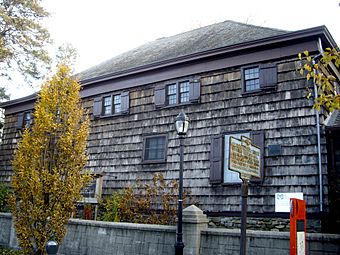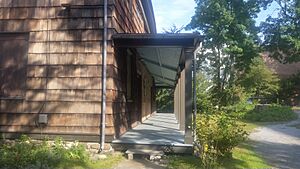Old Quaker Meeting House (Queens) facts for kids
|
Old Quaker Meetinghouse
|
|
 |
|
| Location | 137-16 Northern Boulevard, Flushing, Queens in New York, New York |
|---|---|
| Built | 1694-1719 |
| Architectural style | American colonial |
| NRHP reference No. | 67000015 |
Quick facts for kids Significant dates |
|
| Added to NRHP | December 24, 1967 |
| Designated NHL | December 24, 1967 |
The Old Quaker Meeting House in Flushing, Queens, New York, is a very old and special building. It's a historic place of worship for the Quakers, also known as the Religious Society of Friends. This building is located at 137-16 Northern Boulevard.
It was recognized as a National Historic Landmark in 1967. Later, in 1970, it became a New York City designated landmark. Even today, the Old Quaker Meeting House is still used for Quaker meetings every Sunday.
Contents
History of the Meeting House
Building a Place to Worship
The Flushing Friends Quaker Meeting House was first built in 1694. It started as a small wooden building. The land for it was bought in 1692 by John Bowne and John Rodman. The very first meeting held there was on November 24, 1694.
The original building is now the eastern part of the larger structure you see today. The building was made bigger between 1716 and 1719. Some records say the first part was fixed up in 1704 and then taken down in 1716. This meeting house was the second one built on Long Island. The first one, in Oyster Bay, was built in 1672 but is no longer standing.
Quakers in Early New York
Quakers came to this area from the Netherlands in 1657. At first, they held their meetings in people's homes. Henry Townsend offered his home for meetings. However, he was fined because Quakers were not always welcome.
Quakers sometimes met secretly in the woods. Then, John Bowne offered his home for meetings. Bowne was sent away to Holland for not paying the fine. But he returned two years later to fight for religious freedom.
The group wrote a letter called the Flushing Remonstrance. John Bowne asked the Dutch West India Company in Holland to support religious freedom. In 1663, a letter was sent to Governor Stuyvesant telling him to stop treating Quakers badly.
Inside the meeting house, there is a special partition. This wooden wall can be lowered or raised. It used to separate the men's side from the women's side. Business meetings were often held separately by each group. Then, the partition was raised for the religious meeting.
British Army Occupation
During the American Revolutionary War, the British Army took over the Meeting House. This happened in 1776. They used it as a place for soldiers to sleep, a prison, and a hospital. After the war ended in 1783, the Quakers got their building back. They started using it for worship again.
Keeping the Building Strong
In 1976, experts suggested that the building needed about $70,000 worth of repairs. The old wooden building had problems like dry rot and damage from beetles. A group of volunteers from New York University and the New York State Division for Historic Preservation helped. They surveyed the site to prepare for repair work.
The Society of Friends and a grant from the National Park Service paid for this work. The team checked the ground under the Meeting House floor. They found no important old artifacts. This meant that digging could begin for the repairs.
In 2005, the city set aside $600,000 for needed repairs. These repairs included the roof, gutters, chimney, window frames, and porch. However, by 2006, the work had not started. This was because a lot of paperwork was needed. New building plans had to be approved by the Landmark Preservation Committee. Even though the building needed repairs, it stayed open for meetings and Sunday School.
Graveyard Concerns
The Quaker Meeting House has a graveyard with hundreds of unmarked graves. In 2012, the Religious Society of Friends said that a construction company working next door had dug into their graveyard. The company put up a fence on land that was part of the graveyard. This made the Quaker community very upset because they worried graves might have been disturbed.
The Landmark Preservation Commission warned the company about a $5,000 fine. The company then moved back, but still said they had not disturbed any graves. In the past, it was common for some graves not to have headstones. Rosemary Vietor, from the Bowne House Historical Society, said the disputed area might hold the remains of John Bowne and his wives.
An archaeological survey in 2010 had approved the nearby lot for construction. However, the Quaker community still feels the issue is not fully settled. Descendants of the Bowne family have been asked to help raise awareness about this important issue.
Special Landmark Status
The Friends Meeting House in Flushing was named a National Historic Landmark in 1967. It also became a New York City Landmark in 1970. The New York City Landmarks Preservation Commission said the Meeting House has "special historical and aesthetic interest." They noted its value to the history and culture of New York City.
The Commission also pointed out that it is the oldest place of worship still standing in the city. They said it is a good example of medieval architecture.
See also
- John Bowne House
- List of the oldest Christian denominations in the United States
- List of New York City Designated Landmarks in Queens
- National Register of Historic Places listings in Queens
- List of National Historic Landmarks in New York City



